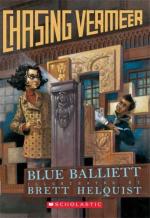
|
| Name: _________________________ | Period: ___________________ |
This test consists of 5 short answer questions, 10 short essay questions, and 1 (of 3) essay topics.
Short Answer Questions
1. What does Petra begin to question?
2. Where are Petra and Calder sitting at the opening to Chapter Sixteen?
3. What does Mrs. Sharpe believe about the woman in Petra's dreams?
4. What does Tommy's latest letter to Calder say?
5. Where does Calder find "The Lady Waiting"?
Short Essay Questions
1. What does the letter from Tommy say and how do Petra and Calder help?
2. What do Petra and Calder learn on the evening news?
3. Who is chasing Petra and Calder and what happens?
4. How does Calder find "The Lady Waiting"?
5. Where does Calder manage to be left behind and what does he find?
6. How do Petra and Calder manage to have access to some of the hidden areas of the school?
7. What happens when Petra enters her kitchen the next morning?
8. What happens to "The Lady Waiting" and how does the National Gallery respond to part of the thief's demands?
9. What do Calder and Petra wonder as they sit in Gracie Hall?
10. How is Ms. Hussey's class metamorphosing?
Essay Topics
Write an essay for ONE of the following topics:
Essay Topic 1
Sometimes a book has more of a character-driven plot rather than action driven, and sometimes it is the other way. Some books seem to balance the two. Discuss the following:
1. What do you think it means to say that a plot is character driven? Action driven?
2. How do you think a plot differs if it is character driven versus action driven?
3. Which type of plot do you find more interesting? Why?
4. Do you think it is possible to have a plot where action and character development share equal time? Why or why not.
5. What type of plot do you think "Chasing Vermeer" is? Explain your response.
Essay Topic 2
The art information given in Chapter 3 encourages young readers to be interested in art and its connection to literature. This chapter is an example of teaching across curriculum and how various school subjects are related. Ms. Hussey gives the students a quote by Picasso regarding how are tells a lie but also tells the truth.
1. Discuss the ways in which art and history are connected. Use examples from the book and your own life to support your answer.
2. Explain what is meant by teaching across curriculum. Use examples from "Chasing Vermeer" and your own life to support your answer.
3. Choose one of the following pairs of school subjects and explain, in detail, how they are connected in real life. Math/English; Science/History; Art/Social Studies or Math/Music.
Essay Topic 3
Chasing Vermeer belongs to the young teen novel genre. Discuss the following:
1. Define the literary term "genre" and give several examples of three other genres in addition to the young teen novel genre.
2. Discuss two reasons why it might be useful to label a text by genre and two reasons it might be disadvantageous to label a text by genre.
3. What do you think is the difference between a young teen novel and a historical novel?
|
This section contains 959 words (approx. 4 pages at 300 words per page) |

|




